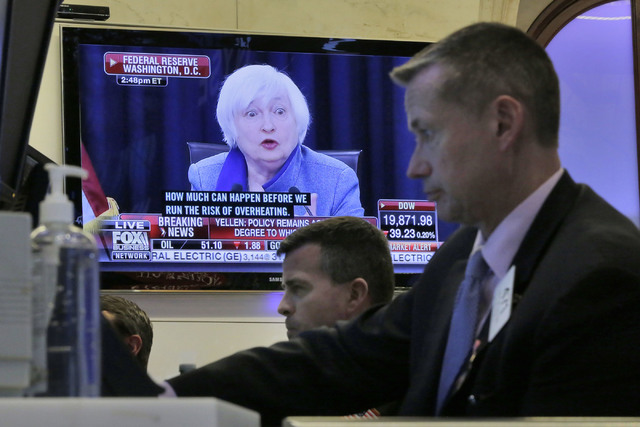Federal Reserve raises interest rates for first time in a year
WASHINGTON — The Federal Reserve has raised a key interest rate in response to a strengthening U.S. economy and expectations of higher inflation, and it foresees three more rate hikes in 2017.
The Fed’s move will mean modestly higher rates on some loans.
The Fed doesn’t directly affect rates on auto and student loans. But credit cards, home-equity loans and adjustable-rate mortgages are based on benchmarks such as the banks’ prime rate, which moves in lockstep with the fed funds rate, and could rise soon, though likely not by much.
Long-term mortgage rates are already climbing but not because of the Fed. Investors have driven mortgage and other long-term rates higher because they expect President-elect Donald Trump’s plans to slash taxes and increase infrastructure spending will lead to faster economic growth and higher inflation.
Wednesday’s action signaled the Fed’s belief that the economy has improved over the past year after a rough start to 2016 and can withstand slightly higher borrowing rates. Its expectation of three rate increases in 2017 is up from two from its forecast three months ago.
The central bank said in a statement after its latest policy meeting that it’s raising its benchmark rate by a quarter-point to a still-low range of 0.5 percent to 0.75 percent. The Fed had most recently raised the rate last December from a record low near zero set during the 2008 financial crisis.
Responding to a question at a news conference, Chair Janet Yellen said she didn’t think the economy needed stimulus from President-elect Donald Trump’s proposed tax cuts and infrastructure spending — the kind of fiscal support that Yellen and her predecessor, Ben Bernanke, had called for in the past.
Yellen said such policies would be unlikely to maximize employment, since the unemployment rate is now slightly below the Fed’s own long-term target.
“My predecessor and I called for fiscal stimulus when the unemployment rate was substantially higher than it is now,” she said.
The Fed chair stressed that she was not providing advice or guidance to the incoming Trump administration. And she downplayed any expectations that Trump’s economic program could lead to faster rate hikes resulting from higher inflation.
The Fed’s move Wednesday, only the second rate hike in the past decade, came on a unanimous 10-0 vote. It also released an updated economic forecast that showed modest changes to its outlook for growth, unemployment and inflation, mainly to take account of a stronger economy and a drop in unemployment for November to a nine-year low of 4.6 percent.
Arvind Menon, CEO of Las Vegas-based community bank Meadows Bank, called the decision a win for retirees living on savings and a hitch for businesses with adjustable loan rates, persons close to the limits of qualifying for a loan and persons hoping to refinance a loan.
For homeowners, fixed-rate loans and those with lengthier periods before rates are adjusted are still attractive, he said.
Projects in the Las Vegas area already under construction are likely safe to continue because the financing for the projects is locked in, Menon said. For future projects, slow increases by the Fed in 2017 should give businesses time to factor higher interest payments into their plans.
“The rates should go up incrementally, meaning we will not see a big, immediate difference,” Menon said.
The Fed will want to see wages grow before its next interest increases in 2017, said Greg McBride, chief financial analyst for Bankrate, a New York-based financial services company.
The American economy is ready to ease into normal interest rates and that Trump’s election hasn’t disturbed that momentum yet, McBride said. The Fed’s governors will need to see the inflation-stoking policies he proposed on the campaign trail in legislative writing before deciding to raise rates faster, McBride said.
“It’s time to wean the patient off the medicine of near-zero interest rates,” McBride said. “You have to do so gradually so as to not disrupt the recovery.”
Some Fed watchers believe low interest rates could be the new normal, said Stephen Miller, UNLV professor and director of the university’s business and economic research center.
Locally, high new-home prices compared to existing homes signal the valley economy is still recovering, he said.
But a low national employment rate will continue to tell the Fed that businesses and individuals can handle rate increases.
“The hope is they are staying ahead of the curve,” Miller said.
The Associated Press contributed to this report.


























